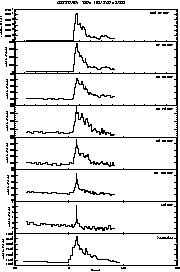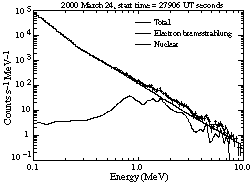Back To OSSE Solar Flare Web Page
2000 March 24 (X1.8)
A GOES X1.8 solar flare occurred on 2000 March 24 at an H-alpha location of N16W82 (heliographic coordinates). The soft X-ray flux began at 7:41 (27660 s), peaked at 7:52 (28320 s), and ended at 7:59 (28740 s) UT (GOES Geophysical Data Web Site). OSSE received a BATSE solar-flare trigger at 27887 s and three of the four OSSE detectors slewed to the scan-angle position of the Sun and initiated +/- 4.5 degree on-source-off-source viewing strategies. Solar observations began at 27906 s UT.
Significant gamma-ray emission to >16 MeV was observed during the subsequent three ~131-second data accumulation intervals (27906-28046, 28046-28177, 28177-28308 s). A data outage interrupted the observation at 28308 s during the decay of the flare. Count rate time profiles in various energy windows at a temporal resolution of ~8 s are shown in Figure 1. The fluxes rose sharply to their maxima within ~35 s and the times of maxima coincided to within 8 sec over the full range of energies. The widths of the peaks became narrower with increasing energy with most of the emission above 16 MeV occurring within 8 s. During that short interval OSSE detected photons up to about 40 MeV. No neutrons were detected.
Figure 2 shows a representative count spectrum obtained from one Sun-pointed detector during the first ~131-second interval which contained the peak of the flare. Electron bremsstrahlung and narrow nuclear lines at 1.6, 4.4, 6.1 and 7.0 MeV can be seen. Spectra from Sun-pointed detectors integrated over the entire flare (up to end of data acquisition) have been fit with model photon spectra. The electron bremsstrahlung component was well-fit with a broken power law having a break energy of ~240 keV. The power-law index was ~3.4 below the break energy and hardened to ~2.4 above. The ratio of the electron bremsstrahlung to narrow nuclear line emission was high compared to other flares, placing this flare in the "electron rich" category. The 2.223 MeV-to-narrow nuclear line ratio for this flare was relatively low, even taking into account its location near the limb of the Sun, suggesting a relatively soft accelerated-ion spectrum at the Sun. The electron bremsstrahlung power law was found to harden essentially continuously with time throughout the flare, from a power law index of ~4.0 before the peak to ~3.3 at the end of the observation. Such hardening has been suggested (Kiplinger 1995, ApJ, 453, 973) to be a good predictor of a subsequent interplanetary proton event. Even though the location on the Sun of this flare was well-connected to Earth, there is no indication in the GOES data for any such event.
 Figure 1 |
 Figure 2 |